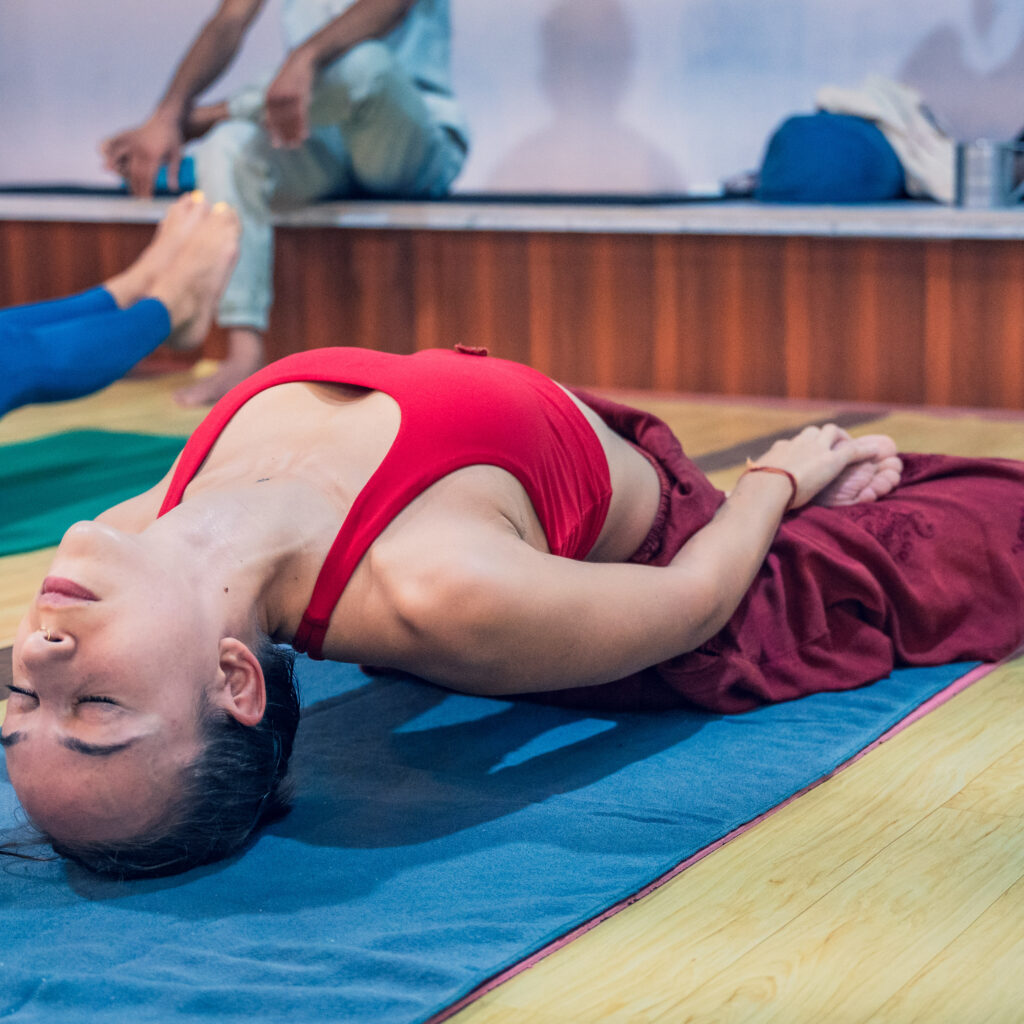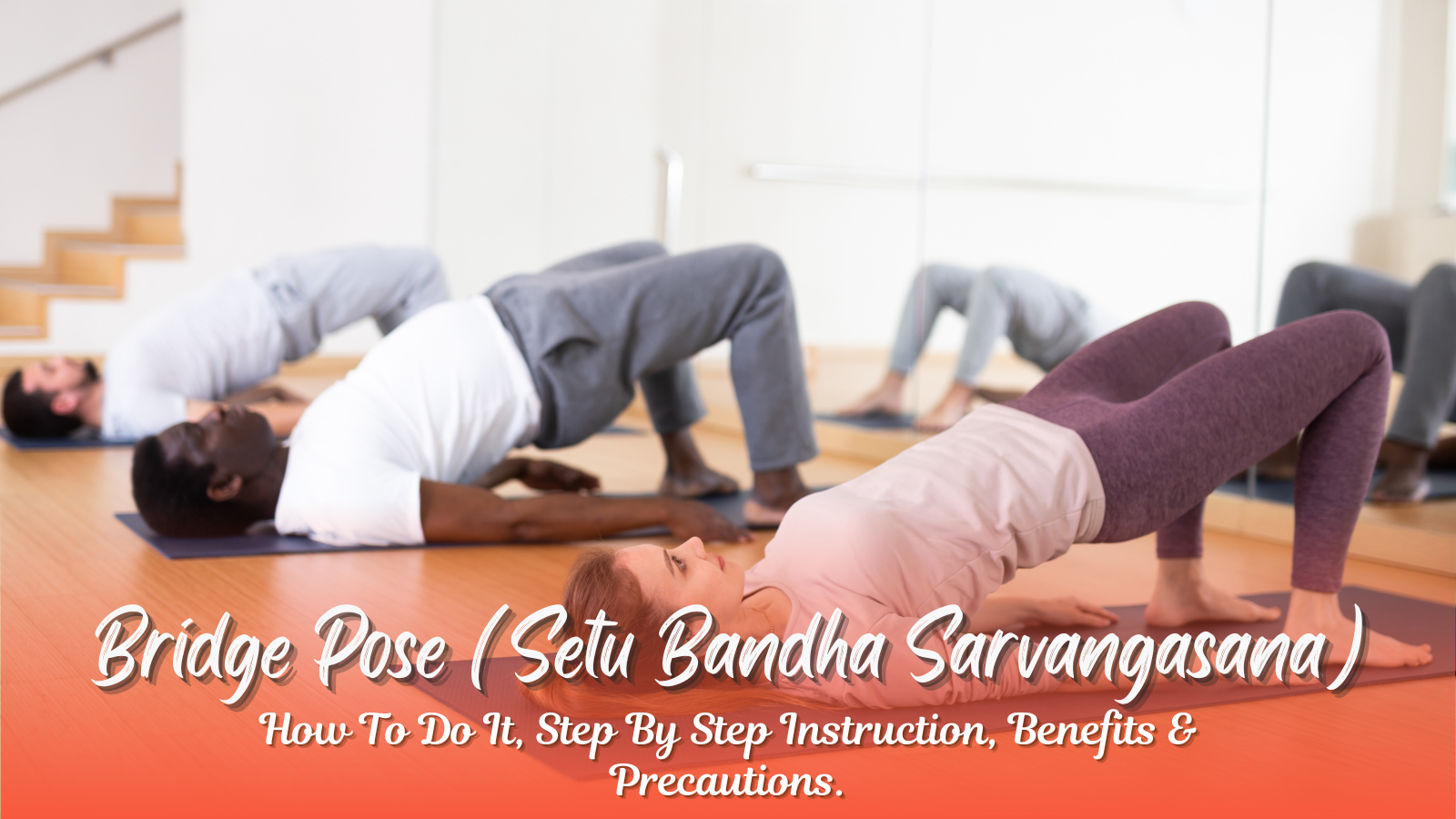Bridge Pose, also known as Setu Bandha Sarvangasana, is a versatile and rejuvenating yoga posture that offers profound benefits for the body and mind. Whether you’re a beginner exploring supported poses or an advanced practitioner delving into challenging variations, Bridge Pose yoga has something to offer for everyone. In this blog, we’ll dive deep into the benefits of Bridge Pose, step-by-step instructions, variations, and precautions to ensure you practice it effectively.
What is Bridge Pose?
- Bridge Pose Defined
- Sanskrit Name: Setu Bandha Sarvangasana.
- The pose resembles the structure of a bridge, hence its name.
- It is a backbend posture that promotes strength, flexibility, and relaxation.
- Why It’s Popular
- Known for its calming and energizing effects, the yoga Bridge Pose is a favorite in restorative and dynamic sequences alike.
How to Do Bridge Pose: Step-by-Step Guide
Mastering the Bridge Pose requires proper alignment and breath control. Here’s how to do it:
- Start with the Basics
- Lie down on your back on a yoga mat.
- Bend your knees and place your feet hip-width apart, with your heels close to your glutes.
- Keep your arms by your sides, palms facing down.
- Engage the Feet and Core
- Press firmly into your feet, ensuring equal distribution of weight across the big toe mound, little toe mound, inner heel, and outer heel.
- Engage your core muscles to support the lift.
- Lift the Hips
- Inhale deeply and slowly raise your hips toward the ceiling.
- Maintain alignment by keeping your knees above your ankles.
- Interlace the Fingers
- Roll your shoulders underneath your body and interlace your fingers beneath your hips for extra lift.
- Open the Chest and Hold the Pose
- Expand your chest and create space in the throat.
- Hold the pose for 5–10 breaths, focusing on even, steady breathing.
- Release Safely
- Exhale as you slowly lower your hips back to the mat.
- Rest for a few breaths before transitioning to the next pose.
Benefits of Bridge Pose Yoga
Practicing the yoga Bridge Pose regularly brings a plethora of benefits for the mind and body:
- Physical Benefits
- Strengthens the Back and Glutes: Engages and tones the lower back, hamstrings, and glutes.
- Improves Spinal Flexibility: Helps maintain a healthy, flexible spine.
- Opens the Chest and Shoulders: Counteracts the effects of poor posture caused by sitting for long hours.
- Enhances Hip Flexor Mobility: Provides a deep stretch to tight hip flexors, promoting greater mobility.
- Supports Thyroid Health: Stimulates the thyroid gland through gentle throat compression.
- Mental Benefits
- Relieves Stress: Acts as a gentle inversion, calming the nervous system and reducing stress.
- Boosts Energy: Improves blood circulation, leaving you feeling revitalized.
- Promotes Focus: Encourages mindfulness by synchronizing movement with breath.
Bridge Pose Variations for All Levels
To make your practice more engaging and cater to different skill levels, try these variations:
- Supported Bridge Pose:
- Place a yoga block under your sacrum for support.
- Ideal for beginners or those with lower back discomfort.
- Advanced Bridge Pose:
- Deepen the backbend by lifting your chest higher and clasping your hands more firmly.
- Suitable for experienced yogis looking for a challenge.
- One-Legged Bridge Pose:
- Lift one leg straight toward the ceiling while holding the traditional Bridge Pose.
- Enhances balance, strength, and core stability.
- Dynamic Bridge Pose:
- Flow between lifting and lowering your hips in sync with your breath.
- Adds a cardio element to your practice.
- Revolved Bridge Pose:
- Incorporate a gentle twist by moving your hips slightly to one side.
- Stimulates the digestive system and increases spinal mobility.
Benefits of Bridge Pose in Yoga Teacher Training
For those pursuing yoga teacher training programs, mastering Bridge Pose is essential:
- Best Yoga Teacher Training in Rishikesh
- This foundational pose is a key component in the 200 Hour Yoga Teacher Training Course in Rishikesh, perfect for beginners learning the basics.
- 300 Hour Yoga Teacher Training in Rishikesh
- In intermediate training, students explore advanced variations like the One-Legged Bridge Pose.
- 500 Hour Yoga Teacher Training in Rishikesh
- This advanced program delves into sequencing Bridge Pose with other backbends for a well-rounded practice.
Precautions and Modifications for Bridge Pose
Precautions:
- Avoid the pose if you have neck, shoulder, or spinal injuries.
- Pregnant women should opt for supported variations or avoid the pose entirely after the first trimester.
- Practice caution if you have high blood pressure or migraines.
Modifications:
- Use a yoga block for added support under the sacrum.
- Keep your feet wider apart for better stability.
- Place a folded blanket under your shoulders to ease the strain on your neck.

Incorporating Poses on a Bridge Into Your Yoga Routine
Bridge Pose fits seamlessly into various yoga routines:
- Morning Yoga:
- Kickstart your day with a gentle flow, including Bridge Pose for an energy boost.
- Evening Practice:
- Use the Supported Bridge Pose to relax and wind down after a long day.
- Strengthening Sequences:
- Combine it with poses like Plank and Warrior II for a full-body workout.
- Restorative Yoga:
- Include the one legged bridge pose with props for a calming, meditative experience.
FAQs About Bridge Pose
- What are the yoga Bridge Pose benefits?
- It strengthens the back, glutes, and legs, improves spinal flexibility, and calms the mind.
- Can beginners practice Bridge Pose?
- Yes! Start with Supported Bridge Pose and gradually progress to more advanced versions.
- What are the benefits of Bridge Pose in yoga for advanced practitioners?
- Enhances core strength, balance, and flexibility when practiced with variations like the One-Legged Bridge Pose.
- What are the precautions for practicing Bridge Pose?
- Avoid the pose if you have neck or back injuries, and always practice with proper alignment.
Conclusion: Why Bridge Pose Should Be in Your Yoga Routine
Bridge Pose (Setu Bandha Sarvangasana) is a timeless yoga posture that bridges the gap between strength and relaxation. From supported Bridge Pose for beginners to advanced Bridge Pose variations, this pose is adaptable for every yogi. Its physical and mental benefits make it a cornerstone in routines across all levels. Whether you’re pursuing a 200 Hour Yoga Teacher Training Course in Rishikesh or simply enhancing your home practice, incorporating Bridge Pose can elevate your yoga journey.
So, roll out your mat, breathe deeply, and let Bridge Pose open new pathways to strength, flexibility, and mindfulness!


